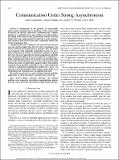| dc.contributor.author | Wornell, Gregory W. | |
| dc.contributor.author | Chandar, Venkat B. | |
| dc.contributor.author | Tchamkerten, Aslan | |
| dc.date.accessioned | 2010-04-16T17:29:32Z | |
| dc.date.available | 2010-04-16T17:29:32Z | |
| dc.date.issued | 2009-10 | |
| dc.date.submitted | 2009-04 | |
| dc.identifier.issn | 0018-9448 | |
| dc.identifier.uri | http://hdl.handle.net/1721.1/53722 | |
| dc.description.abstract | A formulation of the problem of asynchronous point-to-point communication is developed. In the system model of interest, the message codeword is transmitted over a channel starting at a randomly chosen time within a prescribed window. The length of the window scales exponentially with the codeword length, where the scaling parameter is referred to as the asynchronism exponent. The receiver knows the transmission window, but not the transmission time. Communication rate is defined as the ratio between the message size and the elapsed time between when transmission commences and when the decoder makes a decision. Under this model, several aspects of the achievable tradeoff between the rate of reliable communication and the asynchronism exponent are quantified. First, the use of generalized constant-composition codebooks and sequential decoding is shown to be sufficient for achieving reliable communication under strictly positive asynchronism exponents at all rates less than the capacity of the synchronized channel. Second, the largest asynchronism exponent under which reliable communication is possible, regardless of rate, is characterized. In contrast to traditional communication architectures, there is no separate synchronization phase in the coding scheme. Rather, synchronization and communication are implemented jointly. The results are relevant to a variety of sensor network and other applications in which intermittent communication is involved. | en |
| dc.description.sponsorship | University IR&D Grant from Draper Laboratory | en |
| dc.description.sponsorship | National Science Foundation (Grant CCF-0635191) | en |
| dc.language.iso | en_US | |
| dc.publisher | Institute of Electrical and Electronics Engineers | en |
| dc.relation.isversionof | http://dx.doi.org/10.1109/tit.2009.2027484 | en |
| dc.rights | Article is made available in accordance with the publisher's policy and may be subject to US copyright law. Please refer to the publisher's site for terms of use. | en |
| dc.source | IEEE | en |
| dc.title | Communication Under Strong Asynchronism | en |
| dc.type | Article | en |
| dc.identifier.citation | Tchamkerten, A., V. Chandar, and G.W. Wornell. “Communication Under Strong Asynchronism.” Information Theory, IEEE Transactions on 55.10 (2009): 4508-4528. © 2009 IEEE | en |
| dc.contributor.department | Massachusetts Institute of Technology. Department of Electrical Engineering and Computer Science | en_US |
| dc.contributor.approver | Wornell, Gregory W. | |
| dc.contributor.mitauthor | Wornell, Gregory W. | |
| dc.contributor.mitauthor | Chandar, Venkat B. | |
| dc.relation.journal | IEEE Transactions on Information Theory | en |
| dc.eprint.version | Final published version | en |
| dc.type.uri | http://purl.org/eprint/type/JournalArticle | en |
| eprint.status | http://purl.org/eprint/status/PeerReviewed | en |
| dspace.orderedauthors | Tchamkerten, Aslan; Chandar, Venkat; Wornell, Gregory W. | en |
| dc.identifier.orcid | https://orcid.org/0000-0001-9166-4758 | |
| mit.license | PUBLISHER_POLICY | en |
| mit.metadata.status | Complete | |
